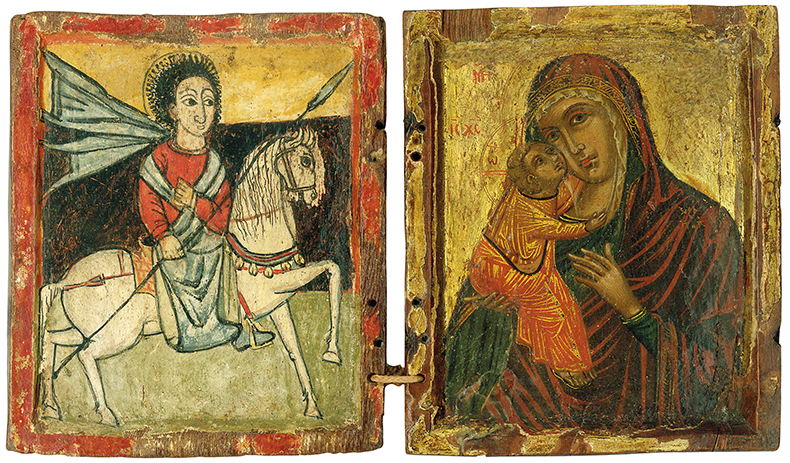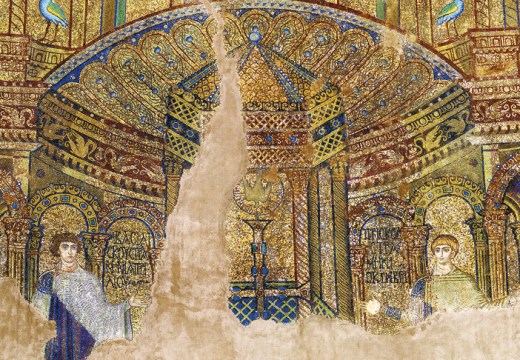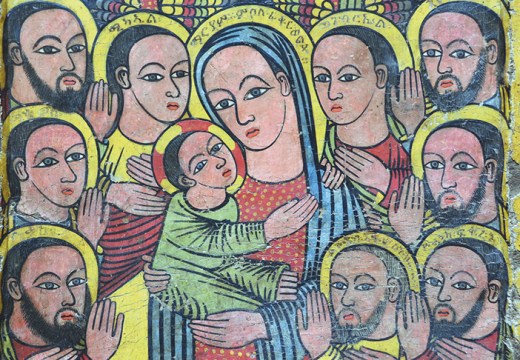From the February 2024 issue of Apollo. Preview and subscribe here.
A recent edited volume of essays asked if Byzantine studies, with its messy heritage of religion, ethnicity, nationalism and geography, is a colonialist discipline. This elegant, gorgeous exhibition provides stimulating ways to rethink that heritage and to map new routes of medieval artistic exchange among Christians of the Mediterranean and of Africa. It is, admittedly, restrained in its arguments – the Met is a stately ship and turns slowly – but this newest instalment of major Byzantine and Eastern Christian shows at the Met is persuasive. Not only does the Mediterranean belong to the Christian traditions bequeathed by the Roman Empire in Constantinople, but so does East Africa. That includes cultures of Copts, Melkites, Nubians and Ethiopians – traditions that are rich historically, still vital, and often neglected in Western accounts of the history of art.
Taking advantage of new research on trade and cultural exchange in the Red Sea and Indian Ocean, the exhibition shows how the geographical limits of the Mediterranean have pinched our imaginations. Here, Byzantium’s reach into Africa is framed not as colonisation but – in the Met’s own terms – as translation, circulation and memory. Rather than demonstrating indebtedness to Christian Roman traditions, the objects are the result of complex and self-aware uses of those traditions to express their own cultures and aspirations.
Museums have been working against Eurocentric histories of art for some time now. The Met certainly has sufficient resources to do so, with its exceptional holdings in African art. In recent years, it has made the case broadly for origins of Western art in Africa through roaming, comparative displays of its ancient Egyptian and African objects. Even an Archaic Greek kouros sculpture of a nude young man, a basis for the Western lineage of naturalistic, human-centred art, has been drawn into the argument with a companion display of a male power figure (nkisi) by a Kongo artist. The Met has been preparing visitors for an inclusive, open history of art: one no longer dominated or dictated by the beautiful nudes of ancient Greece.
It should be noted, however, that this exhibition does not draw aesthetic or functional analogies between the Christian art of East Africa and other artistic traditions of sub-Saharan Africa. Its purview is narrower. The ‘translation’ it demonstrates is fully within the iconographical traditions of Christian art first produced in Roman Late Antiquity (roughly, from the third to the seventh century). The early rooms show these traditions beautifully, nowhere more powerfully than in a sixth-century icon of the Virgin Mary and the Christ Child, with saints and angels, from the Holy Monastery of St Catherine on Egypt’s Sinai Peninsula. This icon is one of the most important works of medieval Christianity to survive – and it does so through the care of the monks over centuries; the monastery was founded in the fourth century and functions to this day.
The icon’s appearance at the Met – perhaps its first trip outside the monastery since its creation, since it may have been painted there, too – is a remarkable accomplishment and a true gift to the world. Its subtle modelling of flesh, its vivid handling of expressions and the convincing interaction of its figures in space reveals the ‘perennial Hellenism’ of Late Antique art, with its resemblance to pre-Christian Greek aesthetic tradition. Seen in this context, however, it also helps demonstrate that the primary claim of Christianity, the birth of God as human, is the bedrock for the visual cultures of all these churches.
That bedrock endures, even after the loss of all Byzantine territory in the Middle East and North Africa with the emergence of Islam in the seventh century. The connections to the former Roman world decreased dramatically, but Christian traditions carried on, translated into new forms, styles and colours. The exhibition signals this cultural and political divergence between Africa and Byzantium with a change in wall tones. The walls in the earlier rooms are a stark, clean shade of ivory. With ‘Africa after Byzantium’ – when Islam is on the rise – the walls are painted a dark grey with an abstract, linear sectioning in that same ivory colour. It evokes both difference and continuity, a strong thematic thread running throughout the show.
The post-Islamic Christian traditions of Africa are shown to be rooted in the early traditions of Christian Byzantium, but they are also revealed to be complex, innovative and very beautiful. The exhibition includes Coptic icons and manuscripts, which reveal a discrete aesthetic sensibility – abstract style, expressive forms, strong primary colours. But it also gathers together less commonly displayed objects and less accessible material. An example would be the medieval frescoes from the lost Nubian monastery of Faras, modern-day Sudan, which are divided now between Warsaw and Khartoum. The figures are outlined with dark, flat lines; they are frontal, hieratic, dominant; they also conform to broader iconographic tropes, like putting wings on angels; and they show different skin tones for living and sacred personages.

Diptych Icon with Saint George and the Virgin Eleousa (left panel: c. 1500; right panel: c. 1580–90). Private collection. Courtesy Metropolitan Museum of Art
The Ethiopian materials have pride of place here, however. They represent strikingly original cultural traditions that also recall much earlier Christian histories of art. The place of the Virgin and Child in Ethiopian art is central, with vivid colours, dynamic poses and deep involvements in her people’s welfare: the Miracles of Mary, an illuminated manuscript from the late 17th century, shows the sequence of events around the Virgin’s healing of a man with a club foot. An arresting diptych demonstrates transcultural communications, with one wing a Saint George painted by an Ethiopian artist, and the other a Virgin and Child, evidently painted in Crete in the late 15th century. It is not possible to know how these two panels came together and the diptych is in an unnamed private collection, so the coupling of Ethiopia and Crete (then a Venetian colony) remains unexplained. But it reminds us of connections between East Africa and Byzantium that we can scarcely imagine – even as such objects challenge us to try.
From the February 2024 issue of Apollo. Preview and subscribe here.
Unlimited access from just $16 every 3 months
Subscribe to get unlimited and exclusive access to the top art stories, interviews and exhibition reviews.














![Masterpiece [Re]discovery 2022. Photo: Ben Fisher Photography, courtesy of Masterpiece London](http://www.apollo-magazine.com/wp-content/uploads/2022/07/MPL2022_4263.jpg)
It’s time for the government of London to return to its rightful home